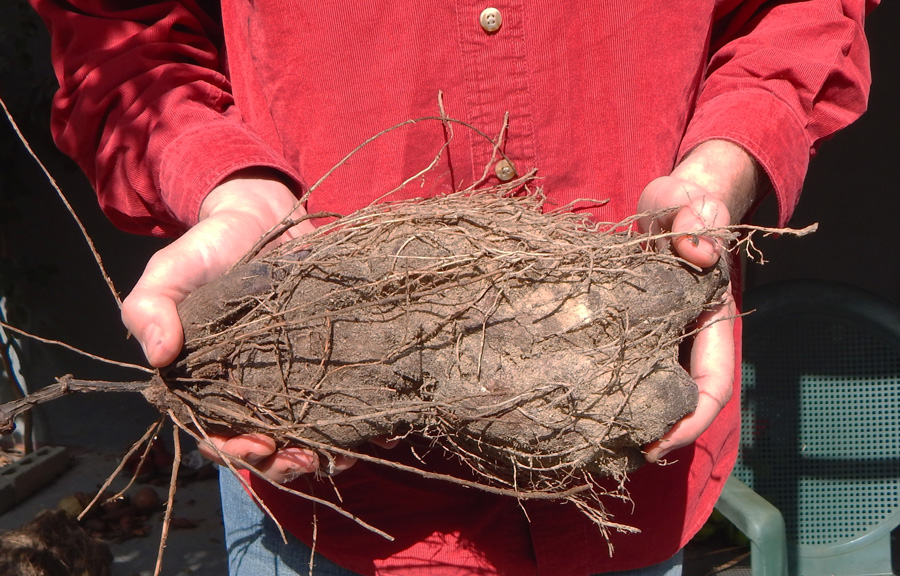Yesterday I was asked whether white Dioscorea alata yams or purple Dioscorea alata yams were better to grow.
“I actually used the link that another commenter left, and ordered a few little fellers on Ebay. There were a lot of the purple yams, but I wanted to start with the white ones. When it comes to eating or growing, do you have a preference? I will probably order some purple ones too. (Unless you say don’t!)”
That is a good question, and it depends on how you gauge your gardening success.
Productivity
The white wild form of D. alata is quite vigorous and gives you a large harvest.
And… the purple yams are purple.
It may be that the anthocyanin content of the purple yams makes them healthier for you, but I’m not sure both are species of D. alata.
We primarily grow the white varieties as they produce excellently and take zero work. The purple varieties also take zero work, but give half the yield.
We haven’t noticed much difference in flavor.
Market Value
There is a catch however, when you compare them in the marketplace rather than for home consumption: the purple yams are almost certainly more valuable on the market, especially if you have a thriving Filipino community.
This year, I plan to grow as many purple yams as possible, with the hope of selling them in Pensacola. The purple variety of D. alata is known as ube yam among Filipinos. It is prized in desserts, especially at the holidays.
One day, Rachel and I drove to at least four different ethnic markets in Pensacola in search of yams at the one market where we found them they were selling ube yam. They cost five dollars per pound. That is a high enough price to make it worthwhile as a crop, especially considering its rarity inside of the United States.
The Verdict
Most backyard gardeners are unlikely to use ube as market crop; hence for maximum production and homestead use, I recommend growing the white wild-ish variety of D. alata, unless you are Filipino or plan to sell your yams to the Filipino community, in which case you should concentrate on purple ube.
Finally, if you can get improved white D. alata types, they are really excellent; however, I haven’t been able to find any inside the US. They are not as vigorous as the big lumpy types, but they are much easier to process and their flesh is less grainy and much better for cooking.





9 comments
Which market did you find them at? Saigon? Bogo? Bien Dong?
ASIA Oriental Market on 90. The woman who ran it was a Christian Vietnamese lady. Very nice to us.
If you are near Panama city, FL and want to find these there is two Asian markets on old 98. The larger market that is slightly more eastward of the other sometimes has them for sale. Also taro corms that will grow. Not the big taro but the smaller ones. The big ones always rot out for some reason. Maybe sprayed with growth inhibitors or something. Believe me I’ve tried multiple times. However the small ones grow no problem. Usually live fruit plants in there too and rare herbs.
Just dug out a ube that has regrown for several years and it was a clump of many individuals. Some of which are several pounds each. Probably in the realm of 60lbs total out of 8 or so large individuals and several smaller ones.
That ube is a boss! If I make it to Panama City, I will visit.
Also, I mailed you a package – you should get it today.
Yes sir just got it yesterday thank you! It’s almost like you read my mind. I was thinking someday I’d like to get some of your landrace project seeds but you already had thrown them in the package. Also the velvet bean pods. I wanted to grow the non itchy type again. Years ago I did but never grew it again. I did grow the itchy type once too. Never ever do that if you haven’t! It produced buckets of pods but the fibers were almost impossible not to get all over you. It was a nightmare cleaning up that vine from a fence. It itches so badly for 30 plus mins you’ll itch your skin off trying to satisfy the irritation. Absolute hell. When some guy had originally sent the seeds he warned me I’d never grow it again but I thought it couldn’t be that bad. It’s that bad and I never grew it again.
YES – the wild itchy ones are horrid. They really will drive you mad. I would never grow them on purpose unless I was protecting a boundary line. The fibers even drift in the air and make you itch without directly touching them.
Sorry about the delay on shipping. I was afraid the box might end up freezing somewhere along the way and was hoping for a warm week. When I saw we had clear temps for a stretch, I dug into my collection to mail you some things. I think you’ll enjoy the weird landrace seeds.
Thanks for the book too! I read a good portion of it as soon as I opened the box.
I am growing every yam I can find, the varieties I bought at Publix and bulbils Sam gave me. I don’t found the purple ones yet. The one labeled Name (Nah-May) looks to be the most appetizing.
The Feb 17th date on the masterclass doesn’t show up in the ad on cellphones or when it does it’s after I hit a comments link. Just pointing it out but it could be something that is only an issue on my phone.
Thank you – I will check on it.
Name is a very good yam.
Comments are closed.